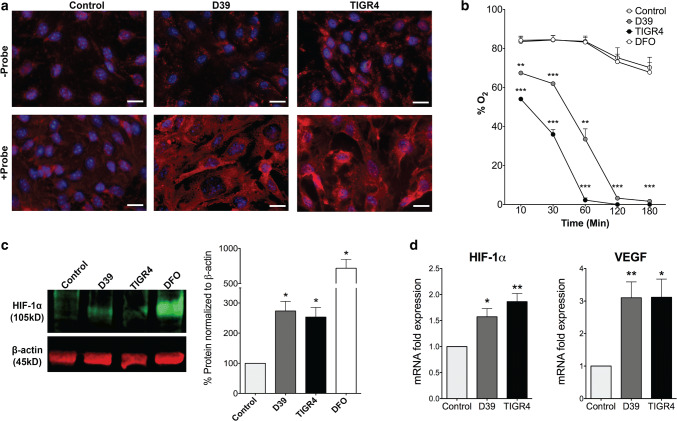Fig. 2.
Hypoxia and HIF-1α/VEGF induction upon S. pneumoniae infection in brain ECs. a Control and S. pneumoniae infected bEnd5 cells treated with pimonidazole hydrochloride (Hypoxyprobe 200 mM) and visualized for cellular hypoxia by red 549-linked mouse anti-pimonidazole monoclonal antibodies. D39 and TIGR4 strains infected cells show significantly high number of hypoxic cells compared to control cells which is however not present in the top row without the probe indicating specificity of the staining (scale bar 10 µm). b Oxygen levels (%) were quantified in the medium of control and S. pneumoniae infected bEnd5 cells using the SensorDish® Reader (SDR) for non-invasive measurement of O2 levels through the transparent well bottom. O2 concentration (pO2% air saturation) was obtained at 60-s intervals and average values at several different time points shown indicate a significant reduction in O2 levels within minutes post-infection and to hypoxic levels by 2 h (N = 3, 2-tailed paired t test compared to control for each condition at the corresponding time point, mean ± SEM, **p < 0.01, ***p < 0.001), which was however not present either in control or deferoxamine (DFO, 200 µM), an iron chelator that induces HIF-1α independent of hypoxia. c Control and S. pneumoniae infected bEnd5 cells were analyzed for HIF-1α protein induction by Western blotting. The result shows a significant increase in HIF-1α levels in both D39 and TIGR4 infected cells compared to control conditions when the band pixel intensity is quantified by normalizing to the housekeeping protein β-actin band. DFO served as a positive control for HIF-1α induction (N = 4, *p < 0.05, 2-tailed paired t test compared to control for each condition). d Quantitative RT-PCR expression analysis (by 2−∆∆Ct method) of control and infected bEnd5 cells shows upregulation of HIF-1α and its transcriptional target gene VEGF upon a S. pneumoniae infection. Expression was normalized to ribosomal protein, large, P0 (RPLP0) that served as a housekeeping gene (N = 6, *p < 0.05, **p < 0.01, 2-tailed paired t test compared to control)

